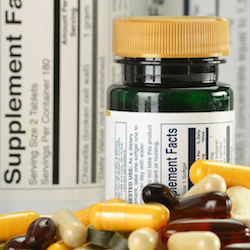Selenium and CoQ10 Abstract
Selenium and coenzyme Q10 is essential for important cellular functions. A low selenium intake is reported from many European countries, and the endogenous coenzyme Q10 production is decreasing in the body with increasing age. Supplementation with selenium and coenzyme Q10 in elderly have shown reduced cardiovascular mortality and reduced levels of markers of inflammation. However, microRNA analyses could give important information on the mechanisms behind the clinical effects of supplementation.
Methods
 Out of the 443 healthy elderly participants that were given supplementation with 200 μg Se/day as organic selenium yeast tablets, and 200 mg/day of coenzyme Q10 capsules, or placebo for 4 years, 25 participants from each group were randomized and evaluated regarding levels of microRNA. Isolation of RNA from plasma samples and quantitative PCR analysis were performed. Volcano- and principal component analyses (PCA)-plots were used to illustrate the differences in microRNA expression between the intervention, and the placebo groups. Serum selenium concentrations were measured before intervention.
Out of the 443 healthy elderly participants that were given supplementation with 200 μg Se/day as organic selenium yeast tablets, and 200 mg/day of coenzyme Q10 capsules, or placebo for 4 years, 25 participants from each group were randomized and evaluated regarding levels of microRNA. Isolation of RNA from plasma samples and quantitative PCR analysis were performed. Volcano- and principal component analyses (PCA)-plots were used to illustrate the differences in microRNA expression between the intervention, and the placebo groups. Serum selenium concentrations were measured before intervention.
Findings
On average 145 different microRNAs out of 172 were detected per sample. In the PCA plots two clusters could be identified indicating significant difference in microRNA expression between the two groups. The pre-treatment expression of the microRNAs did not differ between active treatment and the placebo groups. When comparing the post-treatment microRNAs in the active and the placebo groups, 70 microRNAs exhibited significant differences in expression, also after adjustment for multiple measurements. For the 20 microRNAs with the greatest difference in expression the difference was up to more than 4 fold and with a P-value that were less than 4.4e-8.
Conclusion
Significant differences were found in expression of more than 100 different microRNAs with up to 4 fold differences as a result of the intervention of selenium and coenzyme Q10 combined. The changes in microRNA could be a part of mechanisms underlying the clinical effects earlier reported that reduced cardiovascular mortality, gave better cardiac function, and showed less signs of inflammation and oxdative stress following the intervention. However, more research is needed to understand biological mechanisms of the protective effects of selenium and Q10 supplementation.





